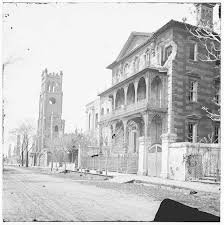The History of Charleston from the Eyes of Mattese Lecque offers a captivating perspective on the city’s storied past. Charleston, known for its rich history and cultural resilience, has been shaped by pivotal moments and remarkable individuals like Mattese Lecque, whose insights provide a vivid picture of its evolution.
This article explores Charleston’s journey, delving into its founding, significant historical events, and cultural contributions while highlighting Mattese Lecque’s profound understanding of the city’s legacy.
Charleston County Founding: A Look Back Through History
The story of Charleston began in 1670 when Charles Town was established at Albemarle Point. Strategically located between the Ashley and Cooper Rivers, the city rapidly grew into a prosperous colonial settlement.
According to Mattese Lecque, Charleston’s initial wealth stemmed from the production and trade of indigo and rice. These industries relied heavily on enslaved Africans, whose labor and expertise were instrumental in the city’s development. Today, the History of Charleston from the Eyes of Mattese Lecque sheds light on these contributions and their lasting impact.
The Royal Era of Charleston: Growth and Splendor
During the Royal Era, Charleston blossomed into a hub of trade, culture, and architectural excellence. This period saw the rise of the iconic Charleston single houses, showcasing a blend of European sophistication and local ingenuity.
As Mattese Lecque narrates, Charleston’s diverse population and vibrant marketplaces were key to its transformation into a significant colonial city. Its thriving economy and unique cultural identity set the stage for its enduring legacy.
Charleston’s Role in the American Revolution
The History of Charleston is deeply intertwined with its role in the American Revolution. One of the most notable events was the Battle of Fort Moultrie, where Charleston defenders successfully repelled British forces.
Mattese Lecque emphasizes how the revolution instilled a sense of resilience in Charleston, which continued to shape its identity in the years to come.
A Dark Chapter: Charleston and Slavery
Charleston’s history cannot be told without addressing its involvement in the Atlantic slave trade. As one of the primary ports for the forced migration of Africans, Charleston’s prosperity came at a great human cost.
Landmarks like the Old Slave Mart Museum and the McLeod Plantation Historic Site preserve this painful yet essential part of the city’s past. Mattese Lecque provides a nuanced perspective on how the resilience and contributions of African Americans have influenced Charleston’s culture and traditions.
Charleston During the Civil War: A City Divided
The Civil War began in Charleston with the firing of the first shots at Fort Sumter. This marked the city as a key battleground in the nation’s most divisive conflict.
Mattese Lecque highlights the struggles Charleston faced during and after the war, particularly during Reconstruction. Despite the devastation, the city’s community came together to rebuild and continue its journey toward progress.
Cultural Evolution and Heritage
Charleston’s cultural evolution is a testament to its adaptability and deep roots in tradition. From sweetgrass basket weaving, a craft rooted in West African heritage, to the iconic “Charleston” dance of the 1920s, the city has continuously embraced its past while celebrating innovation.
Through the lens of Mattese Lecque, Charleston emerges as a city where history and modernity coexist, creating a unique cultural tapestry.
Historical Tourism and Landmarks in Charleston
Today, Charleston is a major destination for historical tourism. The Charleston Museum, America’s oldest, offers visitors a deep dive into the city’s past. Walking tours and reenactments provide immersive experiences for those eager to explore the History of Charleston from the Eyes of Mattese Lecque.
Notable sites like the Battery, Fort Sumter National Monument, and the Nathaniel Russell House Museum are among the many attractions that showcase Charleston’s rich heritage.
African American Contributions to Charleston
The contributions of African Americans are an integral part of Charleston’s story. From Gullah Geechee traditions to the city’s celebrated cuisine, their influence is deeply embedded in its culture.
Institutions like the International African American Museum honor these contributions, as does Mattese Lecque, who continues to highlight their significance in her historical narratives.
Preserving Charleston’s Historic Legacy
Charleston’s charm lies in its well-preserved history. Organizations like the Historic Charleston Foundation and the Board of Architectural Review work tirelessly to maintain the city’s architectural and cultural treasures.
Through the efforts of historians like Mattese Lecque, Charleston’s history is not only celebrated but also protected for future generations.
Conclusion
The History of Charleston from the Eyes of Mattese Lecque reveals a city shaped by resilience, diversity, and a commitment to preserving its legacy. From its founding in 1670 to its pivotal roles in the American Revolution and Civil War, Charleston’s journey is a testament to the strength and spirit of its people.
Whether exploring its cobblestone streets, historic landmarks, or cultural traditions, Charleston offers an unparalleled glimpse into America’s past. With the guidance of Mattese Lecque, its history is more accessible and meaningful than ever.
Discover the History of Charleston from the Eyes of Mattese Lecque and explore its rich heritage. Let Charleston’s timeless charm captivate you. Start your journey today by visiting Pen to Press Publication!
FAQs
What makes the History of Charleston unique?
Charleston’s history is unique due to its rich blend of cultural influences, pivotal roles in major historical events, and its well-preserved landmarks that tell the story of its evolution.
How does Mattese Lecque contribute to Charleston’s history?
Mattese Lecque provides an insightful narrative of Charleston’s past, emphasizing African American contributions, cultural evolution, and historical preservation.
What are must-visit historical sites in Charleston?
Key sites include Fort Sumter National Monument, the Old Slave Mart Museum, and the Nathaniel Russell House Museum, all of which offer a glimpse into the city’s storied past.

